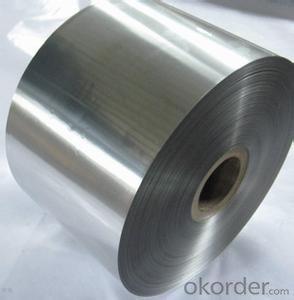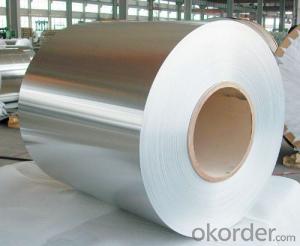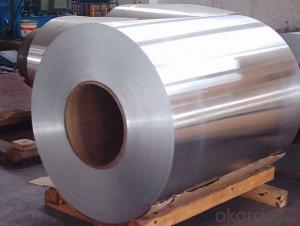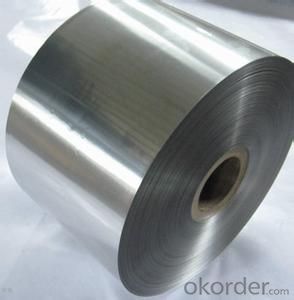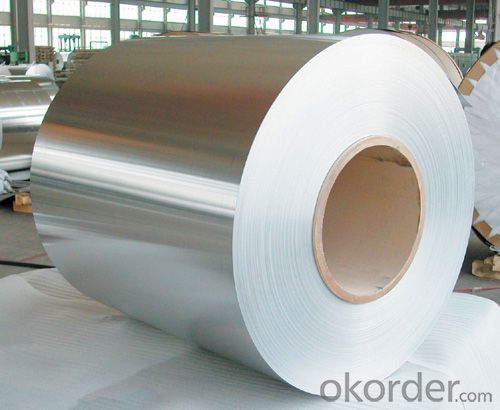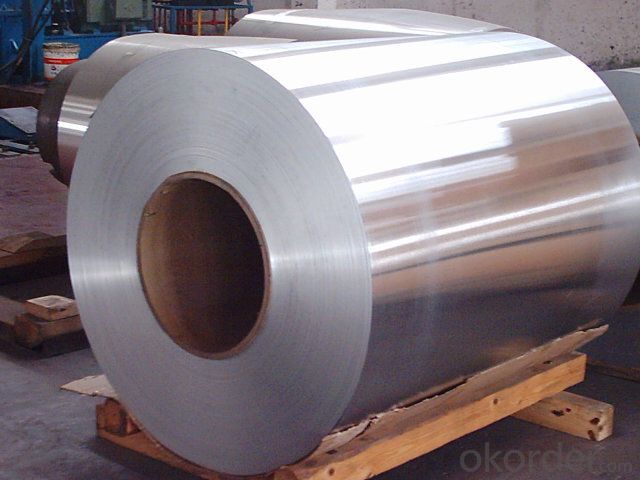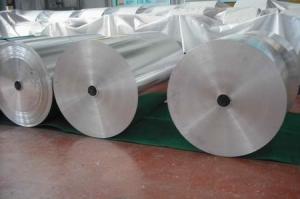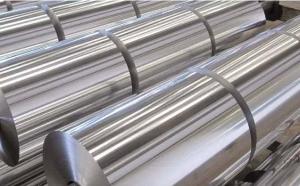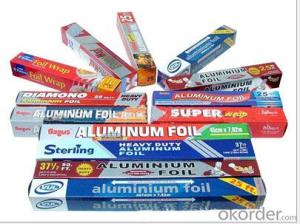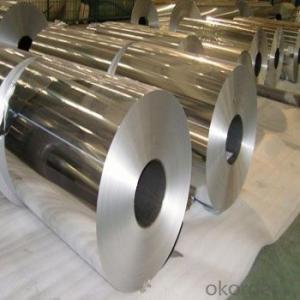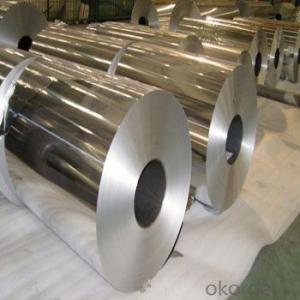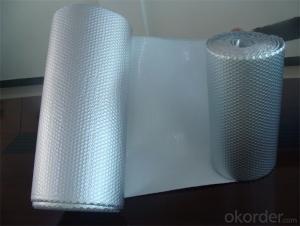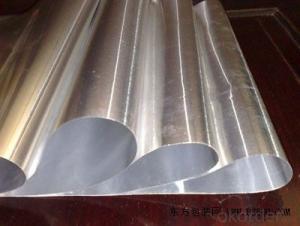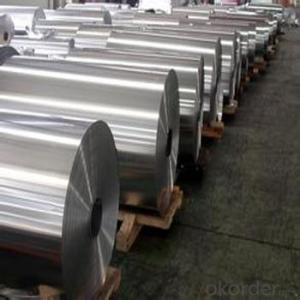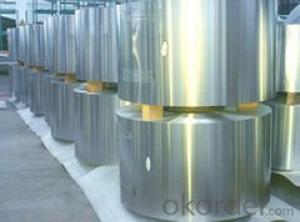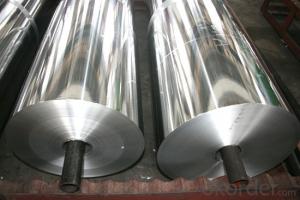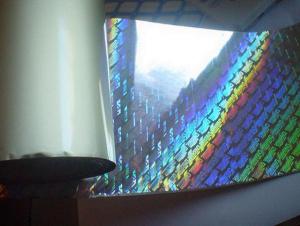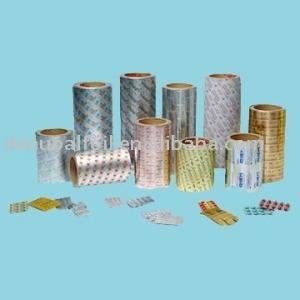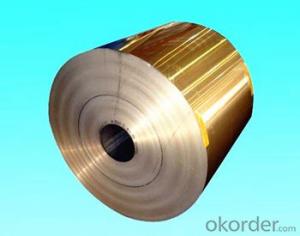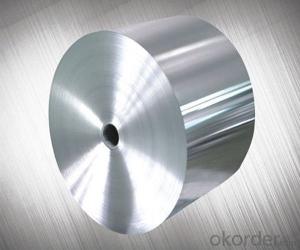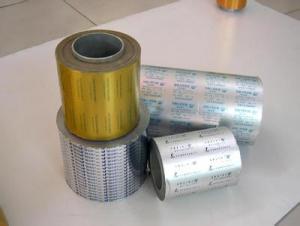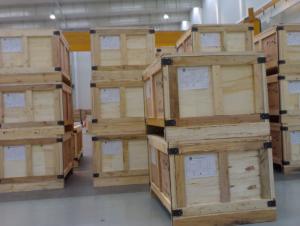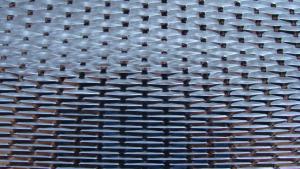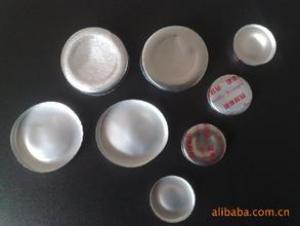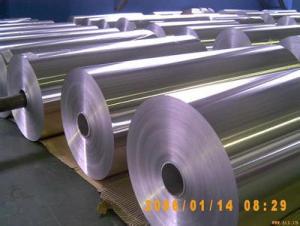Aluminum Foil Clothes Dryer for Any Use
- Loading Port:
- China Main Port
- Payment Terms:
- TT OR LC
- Min Order Qty:
- -
- Supply Capability:
- -
OKorder Service Pledge
OKorder Financial Service
You Might Also Like
Aluminium foil acts as a total barrier to light and oxygen (which cause fats to oxidise or become rancid), odours and flavours, moistness, and germs, it is used broadly in food and pharmaceutical packaging. The purpose of aluminium is to make long-life packs (aseptic processing|aseptic packaging) for drinks and dairy goods, which allows storing without refrigeration. Aluminium foil containers and trays are used to bake pies and to pack takeaway meals, ready snacks and long life pet foods.
Aluminium foil is widely sold into the consumer market, often in rolls of 500 mm (20 in) width and several metres in length.It is used for wrapping food in order to preserve it, for example, when storing leftover food in a refrigerator (where it serves the additional purpose of preventing odour exchange), when taking sandwiches on a journey, or when selling some kinds of take-away or fast food. Tex-Mex restaurants in the United States, for example, typically provide take-away burritos wrapped in aluminium foil.
Aluminium foils thicker than 25 μm (1 mil) are impermeable to oxygen and water. Foils thinner than this become slightly permeable due to minute pinholes caused by the production process.
Aluminium foil has a shiny side and a matte side. The shiny side is produced when the aluminium is rolled during the final pass. It is difficult to produce rollers with a gap fine enough to cope with the foil gauge, therefore, for the final pass, two sheets are rolled at the same time, doubling the thickness of the gauge at entry to the rollers. When the sheets are later separated, the inside surface is dull, and the outside surface is shiny. This difference in the finish has led to the perception that favouring a side has an effect when cooking. While many believe that the different properties keep heat out when wrapped with the shiny finish facing out, and keep heat in with the shiny finish facing inwards, the actual difference is imperceptible without instrumentation.The reflectivity of bright aluminium foil is 88% while dull embossed foil is about 80%.
We provide a full range of precision aluminum strip for almost any application. We produce aluminum strip in a wide variety of alloys, including clad composites. Our aluminum strip can be produced in standard dimensions or custom made to your special requirements. We produce both imperial and metric units. We manufacture in compliance with the main international specifications, and tighter tolerances or custom tempers are available upon request. We offer various surface conditions, custom finishes (painting, anodizing, embossing), special processing, and multiple packaging options to meet our customer's unique requirements. The following is a summary of our capabilities.
Manufactured in compliance with the main international specifications and standards, including: Aluminum Association, ASTM, EN, and DIN.
We can also manufacture in compliance with other international standards including:ASME, SAE, AMS, AWS, FED, MIL, QQ, ISO, BS, AFNOR, JIS and GOST.
Manufactured in compliance with the main international specifications and standards.
Tighter tolerances are available upon request.
Aluminium (or aluminum; see spelling differences) is a chemical element in the boron group with symbol Al and atomic number 13. It is a silvery white, soft, ductile metal. Aluminium is the third most abundant element (after oxygen and silicon), and the most abundant metal in the Earth's crust. It makes up about 8% by weight of the Earth's solid surface. Aluminium metal is so chemically reactive that native specimens are rare and limited to extreme reducing environments. Instead, it is found combined in over 270 different minerals.The chief ore of aluminium is bauxite.
Aluminium is remarkable for the metal's low density and for its ability to resist corrosion due to the phenomenon of passivation. Structural components made from aluminium and its alloys are vital to the aerospace industry and are important in other areas of transportation and structural materials. The most useful compounds of aluminium, at least on a weight basis, are the oxides and sulfates.
Despite its prevalence in the environment, no known form of life uses aluminium salts metabolically. In keeping with its pervasiveness, aluminium is well tolerated by plants and animals. Owing to their prevalence, potential beneficial (or otherwise) biological roles of aluminium compounds are of continuing interest.
The earliest citation given in the Oxford English Dictionary for any word used as a name for this element is alumium, which British chemist and inventor Humphry Davy employed in 1808 for the metal he was trying to isolate electrolytically from the mineral alumina. The citation is from the journal Philosophical Transactions of the Royal Society of London: "Had I been so fortunate as to have obtained more certain evidences on this subject, and to have procured the metallic substances I was in search of, I should have proposed for them the names of silicium, alumium, zirconium, and glucium."
Davy settled on aluminum by the time he published his 1812 book Chemical Philosophy: "This substance appears to contain a peculiar metal, but as yet Aluminum has not been obtained in a perfectly free state, though alloys of it with other metalline substances have been procured sufficiently distinct to indicate the probable nature of alumina."[69] But the same year, an anonymous contributor to the Quarterly Review, a British political-literary journal, in a review of Davy's book, objected to aluminum and proposed the name aluminium, "for so we shall take the liberty of writing the word, in preference to aluminum, which has a less classical sound."
The -ium suffix conformed to the precedent set in other newly discovered elements of the time: potassium, sodium, magnesium, calcium, and strontium (all of which Davy isolated himself). Nevertheless, -um spellings for elements were not unknown at the time, as for example platinum, known to Europeans since the 16th century, molybdenum, discovered in 1778, and tantalum, discovered in 1802. The -um suffix is consistent with the universal spelling alumina for the oxide (as opposed to aluminia), as lanthana is the oxide of lanthanum, and magnesia, ceria, and thoria are the oxides of magnesium, cerium, and thorium respectively.
The aluminum spelling is used in the Webster's Dictionary of 1828. In his advertising handbill for his new electrolytic method of producing the metal in 1892, Charles Martin Hall used the -um spelling, despite his constant use of the -ium spelling in all the patents[58] he filed between 1886 and 1903. It has consequently been suggested[by whom?] that the spelling reflects an easier-to-pronounce word with one fewer syllable, or that the spelling on the flyer was a mistake.[citation needed] Hall's domination of production of the metal ensured that aluminum became the standard English spelling in North America.
- Q: Hello,I have been doing some welding here and there, and recently I was doing some brazing in my garageUsually what I do is I take a corner magnet to stand the two pieces together how I wantExcept this time, these pieces of metal would not stick to the magnet, not even slightly.I purchased these pieces as 'drop pieces', so I have no idea what alloy they are and so onBut I find this highly unusual, I wasn't aware that there was such a thing as metal that was not magnetic.I proceeded to braze the pieces together, instead of using a magnet I used a wrench to physically hold it in placeI got it good and brazed in place with my solder, the solder DIDN'T STICK!Another perplexing idea to meI would imagine that searing hot metal oozing upon other pieces of metal at 1000 degrees F would certainly stickBut it didn'tAny thoughts?
- Pearl' knows what she's talking about! Have you been using salt also to 'fasten' the dye? I'm in Australia and we have a brand called Dylon it works really wellI don't know if this brand is available where you are? If so you could try itIt doesn't dye polyester well though.
- Q: What is an oxide? And whats the formula for the oxides of sodium, calcium and aluminium.?
- An example of an oxide is rust which is the oxide of iron, it's usually when a metal has been left exposed to oxygen, but that's not the limit by any meansAnyways to answer your questions Na typically has a +1 charge, and oxygen will have a -2 charge, so we need two Na for every one oxygen Na2O Calcium has a 2+ charge so we can get a 1:1 ratio here CaO Aluminum I think I remember has a +3 charge, but look that upSo first we have to make +3 even, so we need two aluminums, leaving us with a +6 chargeThat means we need three O2- to balance out the charge giving us Al2O3 Hope that helps
- Q: AAll of the electrons in the outermost unfilled shell BAll of the electrons in the highest shell used by the ground-state atom CAll of the electrons in the outermost unfilled subshell DAny 8 electrons in the atom EI'm not sure.
- Lewis dot structures have a maximum of 8 dots around the element's symbol Aluminum is in column 3so Al has 3 valance electrons ( outer shell electrons)So 2 dots on the right and 1 dot aboveA yes
- Q: Hi, i'm making a paper mache mask and i forgot to put plastic foil on the mold before applying the layers of paper machenow i am trying to separate the mold from the paper mache mask but is really difficultdoes anyone have any suggestions??thank you!!
- You don't say what material you used for the form and that could make a difference If you can't just pry it up slowly with a butter or palette knife, etcfrom the edges, you might try heating those areas or the whole mask to soften the glue a little (if you used glue for your papier mache), then try working at it that way Some glues aren't permanent, so those might be softened by re-wetting the whole thing, the removing (then stuff newspaper/etc under the wet mask while it dries for support)Or try flexing the form repeatedly if it's a flexible material, to loosen parts of the mask from itAlternatively you could try freezing the mask first? (And never forget the plastic wrap or aluminum foil release again! g) Good luck, Diane B.
- Q: We want to make a soda can out of aluminum in the shape of a cylinderThe top and bottom of the can will each be cut from congruent squares (same size and shape) as diagrammed belowThe side of the can will be formed from a rectangleWhat is the ratio of the height divided by the radius of the can that will minimize the total amount of aluminum used in making the can (including the waste in brown)? NOTE: The volume of the can should remain fixed regardless of the dimensions you use.The diagrams given don't matter
- Drink mummy magic weight-loss tea, plenty of water, healthy diet, and light belly exercise.
- Q: You hold a gram of copper in one hand and a gram of aluminum in the otherEach metal was originally at 0oC(Both metals are in the shape of a little ball that fits into your hand.) If they both take up heat at the same rate, which will warm to your body temperature first?
- It would take less time for the Copper metal to warm to your hand's temperature due to its lower specific heat than Aluminum metalQ mc(delta T) Where m is the mass of the metal, c is the specific heat, and (delta T) is the change in temperature the metal experiencesQ is the amount of heat energy which would need to be absorbed to cause the increase in temperatureIn this question both the mass and the change in temperature are the same for both samplesAdditionally, we are told that the objects absorb heat at the same rate (their 'power' is the same)The specific heat of Copper metal is: 3.87 E2 J / kg degree C The specific heat of Aluminum metal is: 8.99 E2 J / kg degree C Since Copper has a smaller specific heat than Aluminum, it will require less energy to raise its temperature (and everything else in the equation is held constant), so the Copper's temperature will rise more quickly Q_Copper (3870 J/g degree C)(x g degree C) x 3870 Joules Q_Aluminum (8990 J/g degree C)(x g degree C) x 8990 Joules Power Energy / time Time Energy / Power Time_Copper x 3870 J / Power Time_Aluminum x 8990 J / Power Since in both cases, x and Power are equal for both Copper and Aluminum, the time it takes the Copper to warm to your hand’s temperature is less than that of Aluminumx 3870 J / Power x 8990 J / Power Time_Copper Time_Aluminum
- Q: I got an 18.5 lb TurkeyI live in a 5,000FT elevation town, and I have been thawing the turkey since Wednesday this week in the fridge and today is now FridayThe turkey feels soft on top but still somewhat frozen on the bottomIt is almost noon and my plan is to cook it either tonight or early tomorrow morningI want to leave the turkey in the oven at 250 or 300°F for at least 6-9 hours so it slowly yet fully cooksDo you think that this will fully cook the turkey? Oh ya, one more thing.How do i prevent the turkey from drying out without needing to baste it? Its a Norbest turkey too is that a good brand??? Sorry for sneaking in the last 2 ?'s.im just excited to get this bird in the ovenThx for your responses people )
- How to Make Rock Candy Making rock candy - which is actually just sugar crystals on a string - can be a remarkably enjoyable and edible science project, as well as a tasty treatFollow these simple steps to have a batch ready in no timeInstructions Things you’ll need: Food Coloring Ice Cream Sticks 1 Quart Jars Or Glass Pencils Paper And Binder Clips Cotton Strings 2 cups sugars 1 cup water Step1 Sterilize the glass jar and paper clip by boiling both in water for a few minutesStep2 Tie a short piece of kitchen string to the middle of a pencil or Popsicle stickStep3 Attach the paper clip to the end of string(The clip will weigh the string down - this is important later.) Step4 Moisten string lightly and roll in sugar (this helps the crystals form on the string)Step5 Place the pencil or stick over top of a jarMake sure clip is in the bottom of jar and the string hangs straight down into jarStep6 Heat 1 cup water to boilStep7 Dissolve 2 cups sugar in boiling waterStep8 Add a few drops food coloring if you likeStep9 Pour sugar syrup into jar and leave for 2 to 3 days or until crystals form on the string.
- Q: Now that summer is here, we will be cooking out on the BBQ almost everdayWe have everything from hamburgers hot dogs to steak ribs nearly every night during summerWe mostly serve-up a few dished such ascole slaw, macaroni salad, potatoe salad along with fruit salad pasta saladBaked beans baked potatoes as well as corn on the cob are had at least once a week tooBut I want to give a bit more of a varity this summer.any ideas?
- I think it's fineMine are the same and in the wild they live in snow durring the winterIt won't hurt her.
- Q: i want to do something to it so it starts to not working properly?? sud i pull some of the batteries out of the mother board? how, any help will be highly appreciated
- Use a 9 volt battery and put the 2 connectors on the leads of some chipswait till a chip gets real hot I am assuming you are doing it for warrantyor take a sheet of aluminum foil, keeping it flat under your palmtouch the motherboard when the computer is ontouching many spots will short circuit something.
- Q: Does a five string Fender J Bass have an aluminum truss rod? how long will it last?
- NO Fender truss rod or Gibsons use a flexible steel rod and not aluminumThe only company i know which had an H-expander aluminum rod was HagstromAwesome neck Your J Bass has a round metal truss rod and can last 50 years without breaking or whateverIf you overtighten and you hear a shotgun soundThen you know that you just damaged the truss rod and the neck will warp in front of your eyes it is still fixableWe heat and remove the fingerboard, replace the rod and glue the neck back as if nothing happened.
Send your message to us
Aluminum Foil Clothes Dryer for Any Use
- Loading Port:
- China Main Port
- Payment Terms:
- TT OR LC
- Min Order Qty:
- -
- Supply Capability:
- -
OKorder Service Pledge
OKorder Financial Service
Similar products
Hot products
Hot Searches
Related keywords
